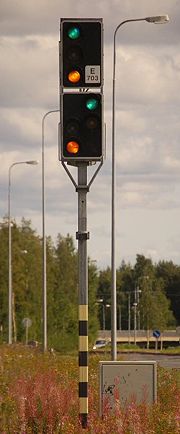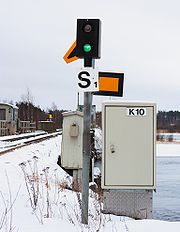
Finnish railway signalling
Encyclopedia

Railway signalling
Railway signalling is a system used to control railway traffic safely, essentially to prevent trains from colliding. Being guided by fixed rails, trains are uniquely susceptible to collision; furthermore, trains cannot stop quickly, and frequently operate at speeds that do not enable them to stop...
used on the railway network in Finland
Rail transport in Finland
The Finnish railway network consists of a total of 5,919 km of railways built with Russian gauge track. Passenger trains are operated by the private state-owned VR Group. They serve all the major cities and many rural areas, though railway connections are available to fewer places than bus...
comprises color-light signals and fixed signs, used together with the Automatic Train Control
Automatic Train Control
Automatic Train Control is a train protection system for railways, ensuring the safe and smooth operation of trains on ATC-enabled lines. Its main advantages include making possible the use of cab signalling instead of track-side signals and the use of smooth deceleration patterns in lieu of the...
system ATP-VR/RHK (an EBICAB
EBICAB
EBICAB is a trade mark registered by Bombardier for the equipment on board a train used as a part of a Automatic Train Control system. EBICAB was originally derived from Ericsson's SLR system in Sweden. Most trains in Sweden an Norway uses a similar on-board system, Ansaldo L10000 from...
900 system better known as JKV).
Main signals
The main signal can have any of the following aspects:| Aspect | Meaning | Old system (Helsinki area) | |
|---|---|---|---|
 |
Stop | The signal must not be passed. | |
 |
Proceed | The signal may be passed with the maximum allowed speed. | |
 |
Proceed 35 | The signal may be passed and the maximum speed of 35 km/h (21.7 mph) is in effect from the next switch Railroad switch A railroad switch, turnout or [set of] points is a mechanical installation enabling railway trains to be guided from one track to another at a railway junction.... , which may lead to the diverging route. An ATC cab display may authorize a higher speed, typically 80 km/h (49.7 mph). The speed is in effect until the next main signal or after leaving the station area. The route may also lead to an occupied track section, but only if the driver has received a preliminary announcement. |
|
If a main signal doesn't protect any switches or the speed restriction on a diverging route is the same as straight route, the signal doesnt't need to show the Proceed 35 aspect and therefore the yellow bottom light may be absent. The two lamp version of the old system has the lights reversed, i.e. red at the top and green at the bottom.
Distant signals
The distant signal is located at least 1200 metres (3,937 ft) before the main signal.It may also be located in the same post with a main signal, below it. In this combined arrangement, whenever the main signal shows a stop aspect, the distant signal doesn't show any aspect at all.
A distant signal can have any of the following aspects:
| Aspect | Meaning | Old system (Helsinki area) | |
|---|---|---|---|
 |
Expect Stop | The next signal shows the Stop aspect. The train route may also be set to a track section without further signals, e.g. toward unsignalled line or a buffer stop. | |
 |
Expect 35 | The next main signal shows the Proceed 35 aspect. | |
 |
Expect Proceed | The next signal shows the aspect Proceed. | |
Note: Although the green light of the old system distant signal used in Helsinki area is named Expect Proceed aspect, the next main signal may in deed show the Proceed 35 aspect. Therefore the driver has to act as if the signal aspect would really be Expect 35.
Block signals
A block signal can show any of the following three aspects:| Aspect | Meaning | |
|---|---|---|
 |
Stop | The signal must not be passed. |
 |
Proceed, expect stop | The signal may be passed. The next main or block signal is showing a Stop aspect. |
 |
Proceed | The next main or block signal is showing a permitting aspect. The following two blocks are not occupied. |
Block signals are being replaced by combinations of main and distant signals, and no new block signals will be installed.
Dwarf signals

| Aspect | Meaning | |
|---|---|---|
 |
Stop | The signal must not be passed. |
 |
Proceed with caution | The signal may be passed, but the track may be occupied by cars or another train. |
 |
Signal cancelled | The signal may only be passed by the unit that has a permission to do shunting or track work. |
A dwarf signal may also be placed in conjunction with a main signal. If the main signal shows any other aspect than Stop, the dwarf signal shows the Proceed with caution aspect.
Bridge signals

Moveable bridge
A moveable bridge is a bridge that moves to allow passage for boats or barges. An advantage of making bridges movable include lower price, due to the absence of high piers and long approaches. The principal disadvantage is that the traffic on the bridge must be halted when it is opened for passages...
. They can have either of the following aspects:
| Aspect | Meaning | |
|---|---|---|
 |
Stop | The bridge is open and the signal must not be passed. |
 |
Proceed | The bridge is closed and the signal may be passed. |
Repeaters
Repeaters are sometimes used to repeat the aspect of the main signal in the Helsinki area in places where the main signal is not clearly visible.| Aspect | Meaning |
|---|---|
 |
The main signal is showing the Stop aspect. |
 |
The main signal is showing some Proceed aspect. The train can be moved to the main signal. |
Helsinki Metro
The Helsinki MetroHelsinki Metro
The Helsinki Metro , is the metro system in Helsinki, Finland. It is the World's most northern metro system, and currently the only one in Finland. The system was opened to the general public on 2 August 1982 after 27 years of planning...
signals differ from those used by the railways.
Main signals
Some aspects may be shown using a signal with only three lights, pictured on the right.| Aspect | Meaning | |
|---|---|---|
| Stop | The signal must not be passed. Forced stopping magnet is active. | |
| Proceed | The signal may be passed with the maximum allowed speed. | |
| Proceed 35 | The signal may be passed. Speed limit after the signal is 35 km/h (21.7 mph). The train may enter a diverging track through a switch. | |
| Coupling | The signal may be passed, but the track may be reserved or is an ending track. Speed limit after the signal is 20 km/h (12.4 mph). | |
| Exception | Drive at driver's responsibility. Forced stopping magnet is active. Speed limit after the signal is 35 km/h (21.7 mph). | |
Distant signals
| Aspect | Meaning | |
| Expect other than Proceed | The next main signal is showing one of the aspects Stop, Proceed 35 or Coupling. | |
| Expect Proceed | The next main signal is showing the Proceed aspect. | |

